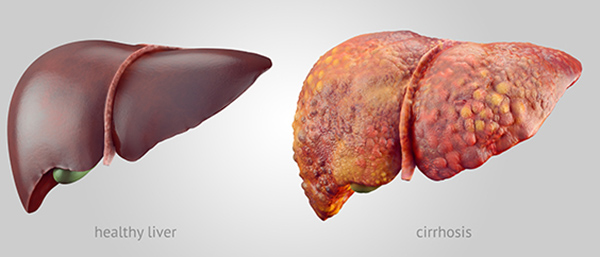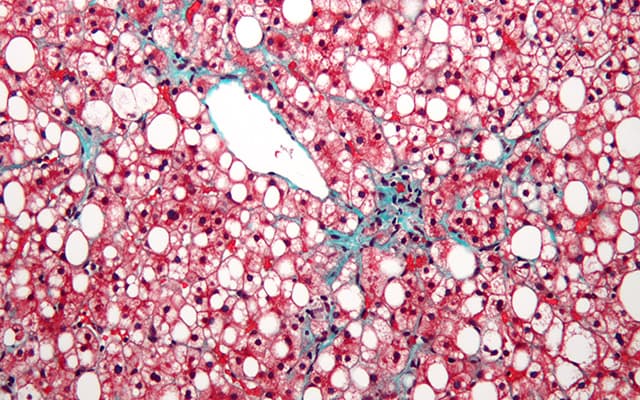Rohit Loomba, MD, has been named chief of the Division of Gastroenterology and Hepatology at University of California San Diego School of Medicine. His new role is effective June 1, 2023.
Tag: Nafld
Potential drug treats fatty liver disease in animal models, brings hope for first human treatment
A potential drug successfully treats the severe form of nonalcoholic fatty liver disease in non-human primates — bringing scientists one step closer to the first human treatment for the condition that is rapidly increasing around the world, a study suggests. Nonalcoholic steatohepatitis (NASH) causes scarring and inflammation in the liver and is estimated to affect up to 6.5% of the global population.
College of Medicine research confirms exercise as treatment for nonalcoholic fatty liver disease
Penn State College of Medicine researchers confirmed exercise can lead to meaningful reductions in liver fat for patients with nonalcoholic fatty liver disease.
Study: First-Degree Relatives of Patients with NAFLD at Risk of Liver Disease
New study identifies that first-degree relatives of patients with nonalcoholic fatty liver disease with advanced fibrosis (scarring of the liver) are at a 15% risk of developing the condition.
Lactating Mice Pass along Common Antimicrobial to Pups, Initiating Liver Damage
In mouse studies, UC San Diego researchers report that lactating mothers expose their feeding pups to triclosan, an antimicrobial commonly used in consumer products, resulting in early signs of liver damage.
Growth hormone improves liver health in people with nonalcoholic fatty liver disease
Growth hormone improves liver health in patients with nonalcoholic fatty liver disease (NAFLD) by reducing liver fat and inflammation, according to a new study presented Tuesday, June 14 at ENDO 2022, the Endocrine Society’s annual meeting in Atlanta, Ga.
Pediatric Liver Disease Increases Risk of Developing Type 2 Diabetes
UC San Diego researchers describe connection between pediatric liver disease and increased risk of developing type 2 diabetes. Both rates are rising in children.
People who consume too much high fructose corn syrup could be at risk for NAFLD
High fructose consumption should be avoided to prevent the development of non-alcoholic fatty liver disease (NAFLD), according to research being presented Sunday, June 12 at ENDO 2022, the Endocrine Society’s annual meeting in Atlanta, Ga.
Diet Plays Critical Role in NASH Progressing to Liver Cancer in Mouse Model
Researchers at University of California San Diego School of Medicine found in a mouse model that when fed a Western diet rich in calories, fat and cholesterol, the mice progressively became obese, diabetic and developed NASH, which progressed to HCC, chronic kidney and cardiovascular disease.
Amino Acid Connected to NAFLD Could Provide Treatment Clues
Basic science research explores the effects of impaired glycine metabolism in nonalcoholic fatty liver disease – and how to potentially use glycine-based treatment to help people with NAFLD.

Antimicrobial Soap Additive Worsens Fatty Liver Disease in Mice
Triclosan, an antimicrobial found in many soaps and other household items, worsens fatty liver disease in mice fed a high-fat diet.
High Abdominal Fat and Low Liver Fat Combo Increases Coronary Heart Disease Risk
Data from a new study presented this week at The Liver Meeting Digital Experience® – held by the American Association for the Study of Liver Diseases – found that the distribution of a person’s body fat affects coronary heart disease risk, with an increased risk of heart events among people with a combination of high visceral adipose tissue (VAT) – abdominal fat─ and low liver fat. The study’s findings indicate that liver triglyceride regulation plays an important role in heart health in people with discordant visceral adipose tissue and liver fat levels.
Cirrhosis in North American Women on the Rise, Trend Especially Worrisome in Young Women
Data from a new study presented this week at The Liver Meeting Digital Experience® – held by the American Association for the Study of Liver Diseases – found that the burden of cirrhosis in women in North America has increased substantially in recent years, a worrying trend driven by a rise in alcohol-related liver disease (ALD) and nonalcoholic fatty liver disease (NAFLD). Projections suggest that both ALD and NAFLD rates will result in even higher cirrhosis incidence by 2040, with the most worrisome upward trends seen in young women with ALD and post-menopausal women with NAFLD.

U.S. News & World Report: UC San Diego #1 for Gastroenterology and Hepatology Research
U.S. News & World Report named University of California San Diego School of Medicine a top global university and ranked the divisions of Gastroenterology and Hepatology #1 in the world for research.
Exercise and Insulin Metabolism in NAFLD
The obesity epidemic has led to an increase in the number of people who have a form of liver disease known as nonalcoholic fatty liver disease, or NAFLD. The disease can cause dangerous levels of fat to build up in…
Study Explores Relationship between Dietary Macronutrients and Fatty Liver Disease Marker
Article title: Nutritional and metabolic regulation of the metabolite dimethylguanidino valeric acid–an early marker of cardiometabolic disease Authors: Jibran A. Wali, Yen Chin Koay, Jason Chami, Courtney Wood, Leo Corcilius, Richard J. Payne, Roman N. Rodionov, Andreas L. Birkenfeld, Dorit…
Sulfatase 2 Plays Role in Development of Obesity-induced Fatty Liver Disease
Article title: Knockout of sulfatase 2 is associated with decreased steatohepatitis and fibrosis in a mouse model of nonalcoholic fatty liver disease Authors: Tae Hyo Kim, Bubu A. Banini,* Faizal Z. Asumda, Nellie A. Campbell, Chunling Hu, Catherine D. Moser, Abdirashid…

Excessive Fructose Consumption May Cause a Leaky Gut, Leading to Fatty Liver Disease
Researchers at University of California San Diego School of Medicine report that fructose only adversely affects the liver after it reaches the intestines, where the sugar disrupts the epithelial barrier protecting internal organs from bacterial toxins in the gut.

Universal Gut Microbiome-Derived Signature Predicts Cirrhosis
UC San Diego School of Medicine researchers report that stool microbiomes of NAFLD patients are distinct enough to potentially be used to accurately predict which persons with NAFLD are at greatest risk for having cirrhosis.

Novel Antisense Drug Shows Promise in Slowing Fatty Liver Disease
A first-in-class clinical trial suggests a novel treatment measurably slowed progression of non-alcoholic fatty liver disease to its more progressive and deadly form.
Bariatric surgery may be effective treatment for non-alcoholic fatty liver disease
Bariatric surgery may be an effective treatment for non-alcoholic fatty liver disease (NAFLD), suggests a new study accepted for presentation at ENDO 2020, the Endocrine Society’s annual meeting, and publication in the Journal of the Endocrine Society.

Study: Two Enzymes Control Liver Damage in NASH
After identifying a molecular pathway that allows nonalcoholic steatohepatitis (NASH) to progress into liver cell death, University of California San Diego School of Medicine researchers were able to use these pathways to halt further liver damage.